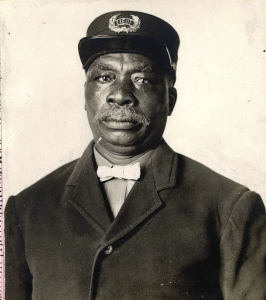
Photo info …
Credit: Indianapolis Public LibraryView Source
(ca. 1843-Nov. 8, 1911). Thomas Smith was born in Kentucky, almost certainly enslaved. He first appeared in Indianapolis in 1870 when he and Mary Melvin Gavin lived on Bright Street. Smith married Gavin in November of 1881. He became one of the first four Black firefighters the city of Indianapolis employed at the end of the Reconstruction era (1856-1876).
In April 1876, Indianapolis mayor directed the chiefs of the police and fire departments to appoint Black candidates to their respective organizations. His decision came in the aftermath of Indianapolis’ Black and white community’s dismay with the exoneration of two Indianapolis police officers charged with the shooting of , an unarmed Black man earlier that month. On May 19, 1876, Thomas Howard, Robert Braxton, James Graves, and Thomas Smith became the first Black professional firefighters in Indiana.
Smith and his cohort of Black firefighters were assigned duty at Hose Reel House No. 9 at the corner of E. St. Joseph and N. Scioto streets. Nine days after their appointment, Chief W. O. Sherwood transferred all the white firefighters from House No. 9 to other fire stations, leaving the four African American firefighters to man the station alone.
Smith and the other three men learned their firefighting skills on the job. A June 5, 1876, article noted they needed to work on laying out hoses and attaching nozzles, but they were quick enough at grabbing their gear, boarding the firefighting carriage, and responding to emergencies.
Nearing the 20th century, all firefighting equipment was horse-drawn. Smith served as the driver of House No. 9’s (which moved to 1602 N. Carrollton Avenue to follow the demographics of the area in 1881) fire carriages throughout his career with the IFD. It took great skill to fight fires but avoiding carriage accidents added to the danger of Smith’s work. In January 1892, Smith sustained injuries when the fire wagon he commanded flipped over. In May 1899, the carriage he drove collided with a wagon, killing Smith’s horse.
Early on November 8, 1911, Smith, by now a 35-year veteran of the (IFD) and a lieutenant at Fire Station No. 16, took the reins of the horse and approached the blind intersection of College Avenue and 16th Street. Smith failed to hear the oncoming southbound electric streetcar, which struck the wooden fire rig, threw Smith from his seat, and killed him instantly. A crane was required to lift the streetcar which became lodged on Smith’s body during the accident. An investigation revealed that Smith was responding to a false alarm.
Smith became the first Black firefighter to die in the line of duty. His funeral procession passed in front of Fire Station No. 16 on its way to , where he was interred in a section reserved for poor people. His body was moved from this section to a lot next to his wife’s lot after her burial in 1930.
Nearly a century after Smith’s death, the Indianapolis Black Firefighters Association dedicated a memorial to him at Crown Hill Cemetery. He is recognized in the Heroes of Public Safety section of the cemetery.

Help improve this entry
Contribute information, offer corrections, suggest images.
You can also recommend new entries related to this topic.

